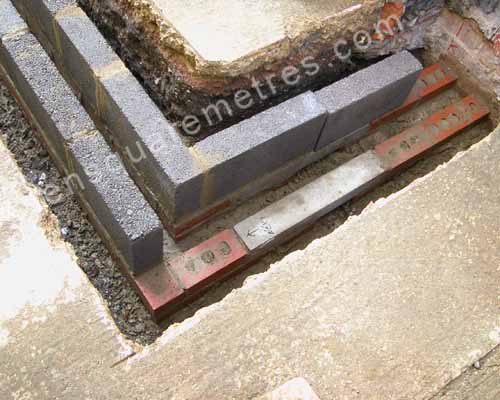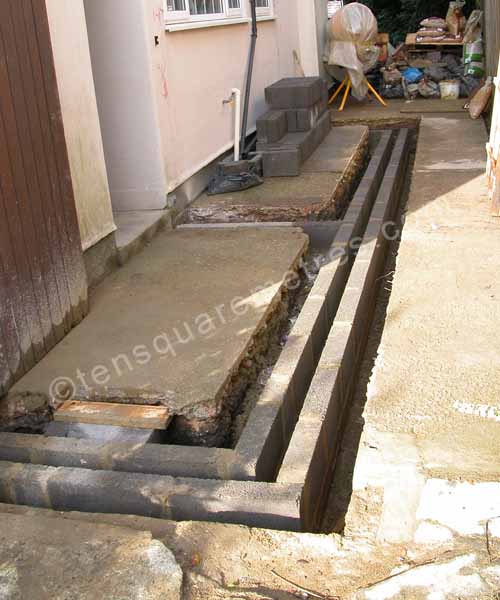GROUNDWORK: ground level
Once you start on this phase of a project you need to get involved with suppliers for your building materials. You will need large pallets of blocks, building sand for mortar and bags of cement. The paper bags of portland cement are cheapest but the yellow plastic bags (Blue Circle Mastercrete Original) are waterproof so can be practical if you need to store stuff outside. They are also good if you get a delivery left in your drive in the pouring rain. I found B&Q generally pretty good. I set up a trade account at the start of the project which gives you free delivery for orders over £50 and they have been fairly reliable. I used Sydenhams quite a lot. Build Centre were good too. For some bits of the project I found I'd get better prices and product range at more specialist suppliers, particularly for the roof and drains. With the exception of B&Q, list prices in these places are always high so make sure get the standard "trade" discount.
 July 2008: The first course completed.
July 2008: The first course completed.
The builder's merchants are also great places to get info and tips. If you go when they are not too busy the guys will usually talk to you about how to go about things and explain what's what in the yard. Obviously B&Q make a virtue of this with the old guys and their trade labels and I have consistently found them really useful. The advantage with the B&Q team is that they are trained to be patient with idiotic people like us. The guys at Sydenhams and Build Centre tend to be a bit more scary!
Getting the blockwork started was an exciting step. A lot of people had told me that getting out of the ground was the hardest part of building something - from there on in you were as good as finished. It wasn't quite like that but it was still a good feeling to be heading upwards. We only needed one course of breeze blocks to get to get the level of the floor slab and one more after that to DPC. Damp proof course is big milestone. The specifications for what we had to do were fairly straightforward too.
According to Building Control, the mortar joints for the blocks needed to be between 5 and 10 mm. This should be a 3:1 sharp sand to cement mix. No lime was needed for what I was doing (lime gives some flexibility to mortar joints and is important for certain types of brickwork to prevent cracking). Section C of the regs also requires that the bottom of the cavity is filled with weak concrete up to 225 mm below DPC. Weak concrete for this was a 10:1 ballast to cement mix. The reason for this is to protect the walls from external pressure below ground level. The damp proof course itself had to be a minimum 150 mm above the final finished surface. In our case this would be the concrete side path. We were allowed to make an exception to this in the doorway so long as we took the DPC membrane down, across and back up.
 July 2008: The first course completed.
July 2008: The first course completed.
If you have found this website useful please tweet / like / etc... and pass it on!
© 2010- tensquaremetres.com | Privacy | Search | Contact | About